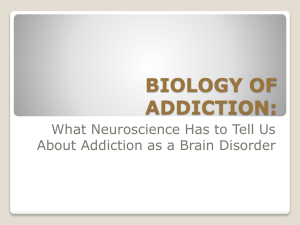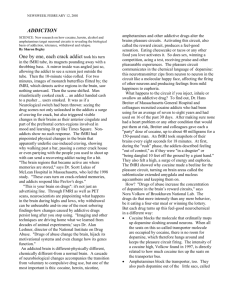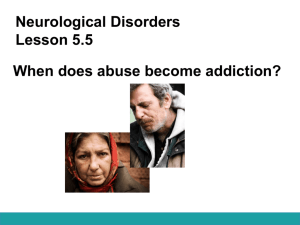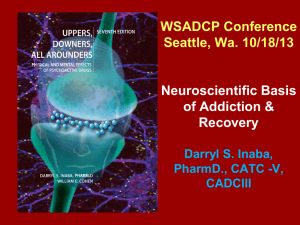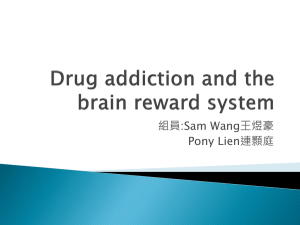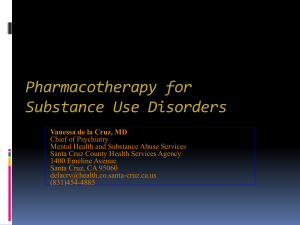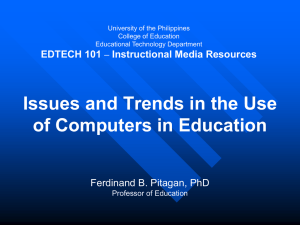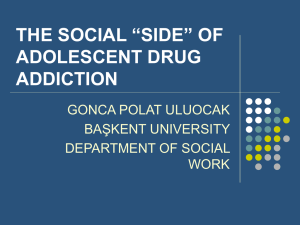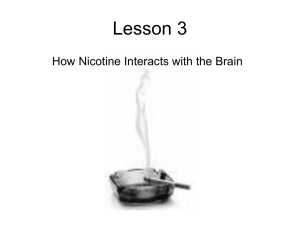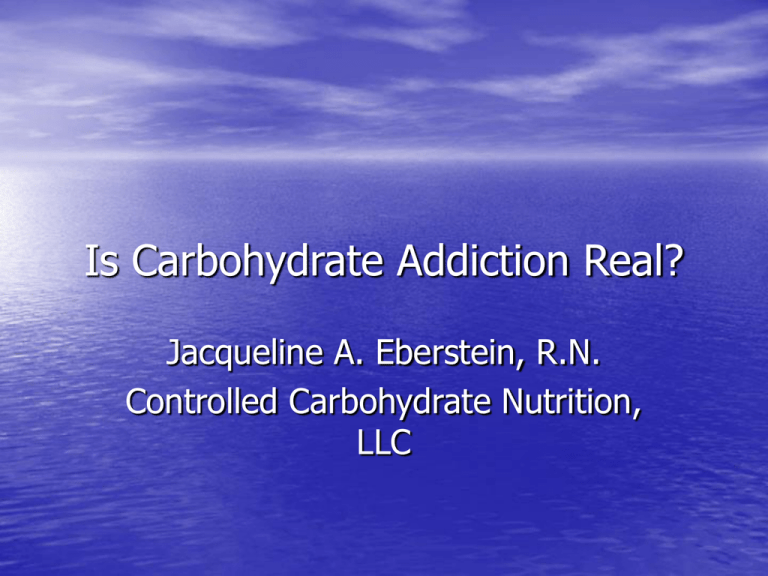
Is Carbohydrate Addiction Real?
Jacqueline A. Eberstein, R.N.
Controlled Carbohydrate Nutrition,
LLC
British Medical Journal 2005
“Sugar is as dangerous as tobacco and
should be classified as a hard drug. It is
harmful and addictive.”
Addictions Are Defined As:
Dictionary.com- “The state of being enslaved to a
habit or practice or to something that is
psychologically or physically habit-forming…to
such an extent that its cessation cause severe
trauma.”
Medical Dictionary-”Habitual psychological and
physiological dependence on a substance or
practice beyond one’s voluntary control.”
American Society of Addiction Medicine
Addiction is a chronic brain disorder characterized by what
happens in the brain (midbrain).
Effects neurotransmission and interaction in the reward
circuitry of the brain.
Leads to behaviors that replace healthy behavior.
Previous memories of experiences with food, sex, alcohol
and other drugs trigger cravings that renew the addictive
behavior. Subconscious Pavlovian response.
Science Daily, January 2012
West R, Theory of Addiction, Blackwell Publishing, 2006
How We learn to Love Sugar
• Begins in the womb by swallowing amniotic fluid.
May be an evolutionary process to distinguish
taste to avoid poisons in the environment. In
nature, poisons are not sweet.
• Breast milk is sweet. Mom’s diet can affect the
taste of amniotic fluid and breast milk. A varied
diet gives child an experience with different
flavors. Breast feed babies more likely to try
different flavors compared to bottle feed babies.
Sugar cont’d
• Increased attraction to sweetness occurs during times of
rapid growth but should decrease in teen years.
• In mammals our sweet receptors evolved in
environments that were low sugar and not adapted to
the super sweet environment that we now face. This has
created an abnormal reward signal in the brain that
overrides control mechanisms and can create an
addiction.
Lenior M., Serre F,et al Intense Sweetness Surpasses Cocaine
Reward PLoS ONE, 2(8) e698.doi: 10.1371. 2007
How Our Tastes Developed
• After birth kids learn to distinguish bitter tastes. Helps kids to
learn to eat foods that are not sweet that contain more
nutrients.
• In the past by the time babies were eating real food, they would
have been much less attracted to sweetness.
• Before the wholesale use of manufactured baby foods, which are
made to be sweeter than the natural food (on purpose), kids
were not as attracted to the taste of processed foods. This is no
longer the case.
• International attempts to lower the amount of sugar in baby
foods from 30 to 10 percent was blocked by the US and the UK.
Facts About Dopamine
• Dopamine is an neurotransmitter involved in
pleasure, learning, memory and motivation.
• Beyond pleasure, dopamine alerts the brain to
pay attention in order to survive. Dopamine can
be increased because of danger, pain and high
carb foods.
• Far more complex than simply a feel good
chemical.
The Chemistry of Addiction
• Communication in the brain from one nerve cell to
another occurs by the production of chemicalsneurotransmitters such as dopamine, serotonin, norepinephrine etc.
• When there is a deficit of dopamine receptors esp. D2A1
there is a pleasure deficit.
• According to research done at the US Dept of Energy
Brookhaven National Lab , obese subjects had fewer
dopamine receptors. The higher the BMI, the fewer
receptors they had.
Addiction cont’d
• People can be born with fewer dopamine receptors.
Fewer dopamine receptors also occur in people with
drug addiction.
• Various substances can produce a rush of dopaminealcohol, sugar, nicotine, cocaine etc. increasing the
experience of pleasure.
• In people with fewer pleasure receptors, over time the
dopamine response will slow requiring more and more of
the needed substance to increase dopamine and
experience pleasure.
Rats Choose Sugar Over Cocaine
• In lab rats symptoms of sugar addiction are similar to
drug addiction: bingeing, withdrawal and cravings.
• Dopamine may be released by increased glucose
concentrations in the brain.
• Sensory input from the mouth!
• Lenior m, Serre F., et al, Intense Sweetness Surpass Cocaine Reward, PLoS
one 2(8), e698. doi:10.1371 2007
Alcohol Addiction and Carbohydrate Intolerance
• In the absence of adequate dopamine receptors resulting in a
pleasure deficit, alcohol has been found to stimulate the fewer
dopamine receptors setting up the pleasure response.
• A particular dopamine receptor has been linked to addiction to
alcohol, cocaine and nicotine. It has also been linked to
carbohydrate cravings and compulsive eating.
• In my clinical experience abnormal blood sugars occur in families
with alcohol intolerance.
• AA meetings –addicts turn to sugar when trying to gain control of
other addictive substances. True of smokers and drug addicts trying
to quit.
Common Addiction Behaviors
• More and more of the dopamine stimulating substance is
required to experience pleasure.
• Addicts are also driven to repeat the dose to avoid
withdrawal. They need another “fix”.
• The part of the brain (prefrontal cortex) responsible for
judgment functions less well leading to diminished
control of the damaging behavior.
Behaviors cont’d
• Preoccupation for getting and eating trigger foods.
Closet eaters. Isolate themselves to partake in their
addictive foods.
• Repeated unsuccessful attempts to moderate intake.
• Continue out of control use regardless of consequences.
What Does Carb Withdrawal Look Like?
• Neuroscientist, Bart Hoebel, noted that sugar withdrawal
may not be as pronounced as it is in morphine but it is
withdrawal.
• Symptoms will temporarily resolve with another “fix”.
• Symptoms can include fatigue, irritability, faintness,
palps, headache, cold sweats, mental cloudiness,
depression.
• Symptoms usually resolve after a few days. Although
preoccupation with the trigger foods can last longer.
How to Break the Addiction Cycle?
• How do alcoholics successfully give up alcohol?
• Accept that you have an addiction and will always have
it.
• Abstinence from the addictive foods.
• Accept that you can’t eat just one.
• Embrace the idea that moderation does not work for
you. Not because you are weak but because you are
carb intolerant.
Break the Cycle
• Get on-going support. Get a buddy.
• Eat properly to support a healthy blood sugar to
diminish cravings and control hunger. Control
the quality and quantity of carbs, eat protein
regularly and don’t skip meals.
• Learn to cope with stress. Exercise in rats can
increase dopamine levels and increase the
number of receptors.
Break the Cycle
• Avoid situations or people who are not
supportive.
• Seek comfort from something other than food.
• Recognize that a Pavlovian response can
continue but the mere thought of your addictive
food does not mean you have to have it. The
thoughts will stop when you no longer give in.
Erase the connection between the stimulus and
the response.
Nora Volkow, director of the National Institute
on Drug Abuse commenting on the recent
research and the controversy about food
addiction states: “The data is so overwhelming
the field has to accept it. We find tremendous
overlap between drugs in the brain and food in
the brain.”
Jacqueline A. Eberstein, R.N.
Controlled Carbohydrate Nutrition, LLC
641 Lexington Ave., 15th Fl
New York, New York 10022
www.controlcarb.com


